# Introduction
In three works composed in the first decade of the 21st century—Achot Ketana (Little Sister, 2000), Zimaar I (2003), and Neharot, Neharot (Rivers, Rivers, 2006)—the Israeli composer Betty Olivero blends together borrowings taken from Western music and Jewish liturgical music, Arab music and Ladino songs. The use of borrowings from Jewish and Arab sources was a notable feature of all of Olivero’s earlier works, but ever since the early 2000s a more prominent role has been given to the combination between these borrowings and Western elements.[1] The different borrowings are not an ornamental element that is foreign to the new music, but a meaningful one that influences its character and stylistic design. In all these works, Olivero builds on a shared idea, a dramatic catalyst that leads to different musical connections between the borrowings. Her attitude toward the borrowed materials is not nostalgic: the past is not a detached, remote sphere that is meant to generate yearning, but rather a relevant element of the work’s present, and so the original materials are recomposed and assimilated into the contemporary musical language.
Olivero’s music has received mentions in important encyclopaedias and lexicons.[2] It has also won awards (The Koussevitzky Award in 2000, the Prime Minister’s Award in 2001 and 2009, and other awards) and has been performed by some of the world’s greatest performers, artists such as clarinet player Giora Feidman, singer Esti Kenan-Ofri, violist Kim Kashkashian, and the Arditti Quartet. In different interviews, Olivero has described her biography and the ideas that guide her artistic work.[3] There has been extensive research focused on her identity as an Israeli composer and on her relation to national trends in Israeli music, but there has yet to be a thorough examination of her musical style.[4] Hence, this article aims to characterize her later style in depth, while focusing on her extensive use of borrowings, on the interplay that is created between these borrowings and the new music, on the meaning that emerges from them, and on the different aesthetic influences behind them.
# The Aesthetic Ideas Behind the Borrowings in Olivero’s Works
# 1. Many Voices
In an interview that was published in September 2013, Olivero stressed her connection to the traditional Jewish sources and to global musical trends as two substantial factors that have both influenced her style. On the one hand, Olivero has declared that her connection with the traditional sources “is becoming more and more necessary for the work as the years go by […] and although the tunes and the liturgical music undergo camouflage in the pieces, whoever knows the sources feels the additional layers in the music, and whoever doesn’t know them will also get the message, because it is a strong motive for my creation.” On the other hand, she also stressed the international influence on her music, which, according to her, expresses many voices, a kind of space or ocean that is shared by all of us: “Before I start writing I ask myself ‘what is going to be heard?’ I don’t know the answer to this question, but one thing I am sure of: that whatever will be heard is many voices, like ‘many waters.’”
In an interview that was published in September 2013, Olivero stressed her connection to the traditional Jewish sources and to global musical trends as two substantial factors that have both influenced her style.
She has described the Avant-Garde period in modern music as a part of a natural process of destruction and rebuilding with which, as with other things, we are in constant dialogue, which “includes things that we did not hear because they are inside of us. And the dialogue crosses the boundaries of time and space.”[5]
Although Olivero avoids limiting herself to a specific dialogue and aims to express all music history through her works, her style clearly points to specific influences that derive from the combination between her identity as an Israeli composer of Mediterranean descent and between her identity as a Western composer. In her childhood in Tel Aviv, as the daughter of parents of Greek origin, Olivero was steeped in Mediterranean culture, which included mainly Greek music and the Ladino language. The same influence has provided Olivero with both textual and melodic raw material, which is open to interpretation in a wider and more substantial way than with other Israeli composers.[6]
According to Olivero, “These autobiographic details are important in my music's content, because during my childhood I was very much exposed to Greek music, which is also strongly influenced by Arabic, Turkish, North African music. It runs in my blood, I'm very attached to these sounds and it comes into my writing almost unconsciously.”[7] Therefore, the use of these sources is intuitive and is not based on ethnomusicological research on the borrowed materials and their origin.
Ladino songs have been featured in her works since the beginning of her artistic journey. Her early work Cantes Amargos (1984) for soprano and large chamber orchestra features fragments from Ladino songs without quotes from the original music, with massive orchestration and eccentric dissonant singing. The song cycle Juego de Siempre (1991) features arrangements of 12 Ladino songs for a singer and a chamber ensemble. In this work, which was composed under the clear influence of Luciano Berio’s work Folk Songs (1964), the textual and melodic connection to the original compositions is preserved and so is the folk singing style. Zimaar I incorporates characteristics from both pieces, and while the singing is in folk style, the orchestration is intimate and closer in character to Juego de Siempre.
Olivero has often blended between Jewish and Arab folklore, as she did in the piece Makamat (1988), which includes Arab songs and Yemenite liturgy music side by side. In later pieces such as Bashrav (2004) and Aria (2005), the composer aimed to create a sonoric Arabic music texture using Western instrumentation. Bashrav is influenced not only by the Arabic sound texture, but also by the original structural form of the Bashrav—one of the most prominent forms in Arabic music, which is based on a main melody (Bashraf) whose melodic and rhythmic qualities are repeated with variations throughout the entire piece. Additionally, along with the original form, the intensity of the musical materials grows throughout the piece, although the drama is balanced with calmer episodes that appear in and between the sections, making the connection to the original form deep and substantial.
Some of the components that characterize Olivero’s style are close to the Arab musical aesthetic. Among these are abundant ornamentation, melismatic melodic lines in vocal parts, heterophony (simultaneous variation of a single melodic line on different instruments, a technique that is common in the instrumental parts that accompany vocal music in the Middle East and Eastern Asia), and free rhythmic stylings (Senza Misura), i.e. the avoidance of bar lines or making free use of bar lines without defined meter in a way that is influenced by improvisational Arab forms such as the Taqāsīm, the Lāyāli, and the Mawāl. Olivero uses all of these forms in a contemporary way, in which the ornaments and the melismatic quality disrupt the linear development of the melodic lines and contribute to a static feeling; the heterophony enables multi-layered textures and a constant incorporation of dissonant frequencies; and the free rhythmic style (beyond diversions from a set meter) enables delays of an improvisational character, which are emphasized through the abundant use of fermatas and the accentuation of the complexity of sound textures.
In her childhood, Olivero was also exposed to Eastern-European tones, which she has incorporated into her works, mainly since the 90s, together with Mediterranean folklore and a style that simulates Klezmer music. For example, L'ombra che Porta il Sogno (2005) is work of Holocaust-themed musical theatre, which incorporates texts of children from the Theresienstadt Ghetto and Yiddish songs, but the piece starts with a Yemenite Piyut that returns towards its ending. At the center of the music for the film Der Golem (1997) there is a clarinet accompanied by a string orchestra, but alongside the klezmer-style playing Olivero incorporates traditional Sephardic tunes. Combinations between East and West, and between Klezmer music and Ladino songs, are featured in other works, such as Bakashot (1996) and Mizrach (1997).
Alongside her Jewish roots, Olivero was deeply influenced by her Western musical education, initially with Leon Schidlowsky and Itzhak Sadai at the Tel Aviv Music Academy, and later with Jacob Druckman, Bernard Rands, and Gilbert Amy at Yale University. An internship with Luciano Berio at Tanglewood in the beginning of the 80s lead not only to additional studies in Italy, but to an extended 18-year stay in the country. Influenced by her different teachers and her prolonged stay abroad, Olivero absorbed tendencies that are characteristic of contemporary music, most notably the use of borrowings from Western music and the extended use of sound clusters. At times, the dissonance of the clusters is accompanied by their homo-rhythmic movement on different instruments, and at times they appear as delayed combinations. In both cases they contribute to the lessening of the sense of movement toward a pre-determined goal and help the listener focus on the musical moment. The fact that they themselves are influenced by non-Western music is a testament to the wealth of sounds that characterizes her music.
# 2. Folklore and Nationalism
The emphasis on Jewish music, mostly Mediterranean, which most of the borrowings originate from, has led to the classification of Olivero as a successor of the collectivist-nationalist movement in Israeli music. In its early beginnings, Israeli music was influenced by the romantic use of folklore as a sign of nationality and by the allure of Eastern culture, which was supposed to represent the new national style but in fact was, to a large extent, aesthetically foreign to the musical language of the group of composers who had emigrated from Europe. The collectivist nationalism appealed to the period and the region, i.e. it tried to create a national style through a sophisticated combination of Western and Arab techniques. The results often made use of folklore as an oriental component that adds ornament and variety to the music through the incorporation of external elements such as rhythmic patterns, ornaments, characteristically Eastern melodic progressions, and an attempt to come closer to the Mediterranean scale system through the use of modes and progressions similar to the Makamat.[8]
When we examine the manifestations of nationality in Olivero’s style, it is important to emphasize, as different researchers have pointed out, that nationalism cannot be easily reduced to a series of clearly-defined national characteristics or certain signs that listeners associate with a specific nationality, but is rather an attitude or a certain mind-set. Therefore, one must examine the aesthetic and musical goals and the role that the different characteristics play rather than simply describe the characteristics themselves.[9] Similarly to the generation of the founders, Olivero was brought up steeped in the Western musical tradition and Mediterranean music is very much present in her works; but to her Mediterranean music is an internal cultural element that she grew up with, not a foreign element which was introduced into the music artificially.
Both the character and the aesthetic message of many of Olivero’s works are an answer to the need for a contemporary language that feeds off of different influences, not necessarily the need for national belonging. Her use of folkloric materials does not just derive from the general tendency of Israeli music to strive for national belonging, but to a large extent from a similar tendency shared by contemporary composers such as Chen Yi and Tania Léon. These composers incorporate in their works themes and specific musical materials that are borrowed from the culture in which they were raised (Chen was born in China, Léon in Cuba), but their musical language is contemporary and influenced by Western composition techniques. Léon showcases cultural pluralism and emphasizes Cuban and African Rhythms, while Chen strives for a profound understanding of folklore and espouses an attitude similar to that of Bartok.
Despite Léon’s extensive use of Cuban cultural influences, her position is similar to that of Olivero in her refusal to define herself as an Afro-Cuban composer or as a nationalist composer, due to how her music, according to her, is the result of her feelings and of a large number of influences from different cultures. The use of materials taken from the composer’s cultural background is, in her eyes, a natural process that takes place not only among modern composers such as George Crumb, but also among classical composers like Beethoven or Brahms, and thus it is not an anomalous attribute that defines her as a nationalist composer.[10]
Despite Léon’s extensive use of Cuban cultural influences, her position is similar to that of Olivero in her refusal to define herself as an Afro-Cuban composer or as a nationalist composer, due to how her music, according to her, is the result of her feelings and of a large number of influences from different cultures.
Berio’s approach, which sees the folk tune a starting point for creativity and personal interpretation, was the most influential one on Olivero. As one of the most prominent Western composers who used traces of folklore in his works from the very beginning, Berio explained that his attempt to understand folklore derives from his personal needs as a composer, and not from any kind of academic motives. His arrangements are a form of analysis of the folkloric works. In other words, Berio emphasizes the deep relation to the songs from a personal perspective, not from an attitude that aims to preserve folklore or showcase it for its own sake:
“My interest in folklore is very long standing […] Recently this interest has put down deeper roots, and I've tried to gain a more specific and technical understanding of the processes that govern certain folk idioms. I tend to be interested only in those folk techniques and means of expression that I can in one way or other assimilate… I am not an ethnomusicologist, just a pragmatic egoist. I tend to be interested only in those folk techniques and means of expression that I can in one way or other assimilate without a stylistic break, and that allows me to make a few steps forward in the search for a unity underlying musical worlds that are apparently alien to one another.”[11]
At the end of the first decade of her work, Olivero expressed a similar attitude toward the use of Jewish sources. To her, these sources are an inspiration, but they undergo many changes due to personal interpretation:
“Besides Western music, which I was brought up and educated on, I find infinite sources of inspiration and enriching musical materials in the music of the different Jewish diasporas. I do not search for these materials out of a scientific-academic-musicological impulse. They serve me as a pure dramatic generator. Sometimes, a deep attentive look into them shows hidden musical means (completely without self-consciousness or intention) and they invite an expansion of the material and its development. I never use all of these means in their primary form as musical quotations. The materials undergo a transformational process to a point in which their original form is changed beyond recognition, to a point in which it is lost while the original spirit and the dramatic content are preserved in their entirety.”[12]
The substantial connection to Berio does not derive just from the use of folklore and quotations from compositions or from similar orchestration qualities, but from the interpretative approach toward the processing of the material, which is used as the basis for a personal presentation, a kind of non-academic “analysis” of the folklore sources.
# 3. Borrowings from Western music and Postmodern tendencies
Olivero’s use of borrowings that are taken from earlier works in music literature is part of a prominent phenomenon in modern music. One of the first composers to make significant use of hymns, anthems and American songs, as well as borrowings from earlier compositions, was Charles Ives. In his research on Ives, J. Peter Burkholder described the different ways in which Ives incorporated borrowings in his works, some of which are shared by Olivero. Ives used paraphrases on earlier tunes and borrowed sections, or whole pieces, which created a melody, a theme, or a new motive. Additionally, he used melodic, harmonic, and structural characteristics, among other things, as models for new pieces, with a stylistic allusion in which there is no quotation, but the “spirit” of the original is transmitted in different ways, through the use of medleys of melodies or of fragments from the original material, of patchworks of simultaneous excerpts, and of complex collages of multiple melodies. The techniques of cumulative settings—in which motives from the original material appear and are developed throughout the piece but the borrowed material only appears in full at the ending—are unique to Ives.[13]
Olivero often uses different paraphrases on the original material and simultaneous uses of borrowings and quotations from different sources. At times, there is a sense of stylistic allusion without an explicit quotation. The specific appeal to Baroque borrowings in Olivero’s work is part of a significant phenomenon in the second half of the 20th century. The works of Bach served during this period as a model or as the basis for new interpretations in many works, among which one can find, for instance, George Rochberg’s Nach Bach (1966), a fantasy for harpsichord which blends thoroughly transformed fragments from Bach’s Keyboard Partita No.6 with free atonal writing; Lucas Foss’ work Baroque Variations (1967), which uses materials by Handel, Scarlatti, and Bach; and Sofia Gubaidulina’s Offeratorium (1980), which opens with a theme from The Musical Offering as the basis for a dodecaphonic row.
Berio’s work Recital for Cathy (1971) opens with excerpts from two madrigals by Monteverdi. In a 1984 arrangement of L’Orfeo—presented by Berio at the Maggio Musicale Fiorentino festival as a kind of open air display featuring early instruments, a rock band, a wind ensemble, and an electronic tape—five young Italian composers, Olivero among them, presented their arrangements of different parts of the Monteverdi opera. This project clearly played a crucial role in Olivero’s choice of Monteverdi, and of his opera, as the basis of the work Neharot, Neharot.
Olivero’s teachers in the United States, Druckman and Rands, also used an abundance of Baroque borrowings. In his work Prism (1980), Druckman incorporates in every movement different versions of Medea— versions written by Charpentier, Cavalli, and Cherubini in the 17th and 18th centuries—using the material in a neo-romantic approach that emphasizes the emotionally expressive quality of the borrowed fragments, which are presented, as the title suggests, in a prismatic way and re-emerge as a unified whole in the context of atonal harmony.
Rands constructed his 1977 work Madrigali around Monteverdi’s 8th Book of Madrigals. According to Rands, the work simultaneously appeals to the original music and to Berio’s arrangement of the dramatic madrigal Il Combattimento di Tancredi e Clorinda (1624). This gives the work several layers of interpretation, both in relation to the original and to its treatment in the new work. Besides the Lamento Della Ninfa, there are no direct quotations in the piece, but the original work served, according to the composer, as a model for a parallel musical language.[14]
Olivero’s style, which blends borrowings from different sources, both folk/popular and artistic, is influenced by the postmodern approach in music. This approach accentuates the understanding of contemporariness not only as a breaking of the past, but as its expansion, using many allusions and quotations from different sources and breaking the barriers between folk/popular music and artistic music, between “high” music and “low” music. In her article on the relationship between postmodern architecture and postmodern music, Jane Piper Clendinning explains that one of the most notable characteristics of musical Postmodernism is the juxtaposition of conflicting ideas, which at times appear in a multi-layered, simultaneous manner. She lists a number of characteristics that originate in the characteristics of architectural Postmodernism, characteristics that include, among other things, ambivalence and the extensive use of ornaments for their own sake, notable characteristics of Olivero’s work.[15] It is important to note that the meaning of cultural pluralism, which is often seen as a sign of postmodern writing, is not the use of different materials that have no relation to one another in a kind of eclectic collage, but rather, as I will demonstrate in the works that will be discussed, a choice of specific materials that influence, and are influenced by, each other.
Olivero’s style, which blends borrowings from different sources, both folk/popular and artistic, is influenced by the postmodern approach in music.
# The Music
In the works that the musical analysis focuses on, the Mediterranean layer and the contemporary layer merge with the historical layer of Western music. This merger, which initially looks like an impossible clash, leads to the discovery of conceptual connections between the sources, which translate into clear musical connections. In the piece Achot Ketana for soprano, three violins, clarinet, and strings, a piyut that has the same name as the one used by the Jews of Florence in Rosh Hashannah is blended with the Chaconne from Bach’s D Minor Partita BWV 1004, one of the most well-known works in music literature. Despite the difference between the cultural-artistic context of the Chaconne and the traditional context of the piyut, both works, according to the composer, carry an abstract context of prayer, which is expressed explicitly in the piyut and in a more abstract manner in the Chaconne.[16] Zimaar I was originally composed for a soprano, two violins, cello, an amplified harpsichord, and percussion (in the second version a clarinet is added and a harp replaces the harpsichord). In this piece, a personal, emotional tone is emphasized, one shared by Ladino songs taken from different Jewish congregations along the Mediterranean and the chant of a French Troubadour which is juxtaposed to them.
Neharot, Neharot —which was composed for a unique instrumental ensemble that includes a solo viola, an accordion, two string sections, and several percussion instruments—also incorporates a magnetic tape with voices of mourning women from Mediterranean countries. Like Zimaar I, this work also appeared in a second version, entitled Madrigal (2007), in which the clarinet replaces the viola as the solo instrument. Neharot, Neharot is largely based on materials borrowed from the works of Monteverdi, including a madrigal from the 8th Book of Madrigals and different excerpts from the opera L’Orfeo. The considerable cultural-aesthetic distance between the sources is bridged by the idea of grief that they both share, which is stylized in the framework of the Western-art-music tradition of the Lamento and simultaneously represented by the common lament. The shared fate and the tension between these expressions of mourning are a central theme in the work and an important influence on its character and stylistic design.
The analysis of the borrowings is largely based on the typology developed by Burkholder, which emphasizes the importance of treating borrowings by Ives and other composers as a separate area of study and opposes the use of the general term “quotation” to describe all forms of borrowing. Burkholder not only describes in detail many different forms of musical borrowing, but suggests a series of questions to help examine the relation between the original material and the borrowed material, the degree of change the borrowed material has gone through, the way the borrowed material influences the design of the work, and its musical and associative (or extra-musical) role.[17]
Accordingly, the following discussion of the musical borrowings will examine the relation between the borrowed original and its appearance in the new work, the ways in which the different borrowed materials influence each other, and how the materials are assimilated into contemporary musical language. In general, the interpretation of the original materials includes quotations with both closer and more distant paraphrases, the simultaneous blending of several melodic lines, and, occasionally, the use of the borrowed material as a harmonic and structural model. Additionally, there are clear extra-musical connections between the borrowed material and the new work. The borrowings Olivero uses, which are mostly Western, are taken from very well-known works, making it clear that her use of them is intentional and that she expects the potential listeners to recognize them and understand the connection between them and the new work. The preservation of some of the clear characteristics of the original materials does indeed help with the identification of the original, but it simultaneously assimilates the borrowed material into the new musical language.
# (1) Bach and Jewish Liturgy in Achot Ketana
Achot ketana tefiloteha / The little sister prepares her prayers
Orcha ve'ona tehiloteha / And intones her praises.
El na refa na le'machaloteha / O God, we beseech Thee,
Tichle shana ve'kileloteha / Heal now her infirmities.
El na refa na le'machaloteha / May the year and its misfortunes
Tichle shana ve'kileloteha. / Now cease altogether.
This text and its musical setting are the basis for the vocal part in Olivero’s piece Achot Ketana. The text of the piyut was written by Avraham Gerondi, a 13th century Rabbi and mystic from Catalonia who was a member of the inner circle of Nachmanides. The Little sister is a metaphor for the people of Israel, and the text features a request from God to save his people and heal its wounds.
The music for the piyut, which was most probably written near the end of the 16th century and performed by the Jews of Florence, was chosen by Olivero from several traditional musical settings of this prayer.[18] The second part has a measured, dance-like style, but Olivero chooses to use the opening part, which is characterized by free rhythmic movement. The melodic movement is dense and ornamental, and the harmonic basis of the music vacillates between the Aeolian mode and a harmonic minor scale. At times, the seventh step is heightened (F-F-sharp), and it serves as an ornament to G and alludes to a harmonic movement back toward the opening sound at the ends of phrases (Tefiloteha, Tehiloteha, Machaloteha, Klaloteha).
The inscription in the title of Achot Ketana—In Memoriam—is in honour of the famous violinist Yehudi Mehuhin (1916-1999).[19] This dedication lead to a choice of a dominant violin texture and to the use of Bach’s Chaconne as the basis for the melodic material of the instrumental ensemble alongside the piyut referenced in the title, which accentuates the importance of the Jewish piyut as the basic melodic material of the vocal part. Olivero describes the choice of the materials for the piece as a string of associative connections:
“Menuhin, violin, the violinist, who is a Jewish violinist, and ’Yehudi’ [Jewish] is his name, so I thought to myself: A Jew is related to prayer; but the violin is also Bach’s Chaconne, which is the crowning achievement of violin literature. And the Chaconne is also polyphony, so I rewrote the different voices for three violins. The orchestra is an expansion of these three soloists, the clarinet is a thin allusion to a Jewish prayer, and the soprano is the voice that sings the prayer: Achot Ketana.”[20]
The Chaconne and the piyut serve as raw materials from which the music draws melodic, harmonic, and rhythmic characteristics, as well as dynamic attributes and abundant ornamentality. The Chaconne first and foremost serves the function of bringing out the violin through the large violin ensemble: three solo violins are joined by six more violins in an orchestral ensemble, and they all create a polyphonic texture together. Additionally, it serves as the origin for the D minor tonal surroundings; of quotations of melodic motives and harmonic progressions, which influence not only the violins’ motivic material, but also that of the other instruments; and of the choice of a three-quarters time signature in most of the sections in which the meter is measured. When there are clear fragments from the Chaconne, the music is characterized by a dramatic dynamic intensity and the use of appoggiatura patterns that resemble the broken chords of the harmonic progression that opens the original work.
The preservation of a close relation to the borrowed material, together with the extreme change that it undergoes, stand out right at the beginning of the piece. The accentuated intervals are taken from its main motive—the fifth between A and E and the second between E and F—and appear in the original meter of the Chaconne, but in a completely different context. The dramatic tension at the beginning of the original phrase, which results from, among other things, the extension of the opening D minor chord and is expressed in a rise toward a high E, dissolves already in the first bar through the extension of the second note and a dynamic accentuation of the first note. In the following bars the perfect fourths and fifths gradually turn into dissonant combinations. Against the backdrop of these delayed combinations, the opening theme of the Chaconne explicitly appears.


The main attribute of the paraphrase on the role of the solo violin is the splitting of the harmonic progression that serves as the main theme of the Chaconne between the three violin soloists, whose parts join each other in a kind of heterophonic dialogue. Simultaneously, the lyrical, improvisation-like character of the piyut influences not only the vocal line, which is partially crafted in a free-rhythm framework, and the harmonic framework, which shifts between tonal and modal harmony, but also the character of the ornamental patterns in the violins and the clarinet, which are based on the melodic material from the Chaconne but are simultaneously crafted as Mediterranean ornaments
The main motives taken from the Chaconne are the opening harmonic progression (bars 1-9) and the ornamental patterns that are based on the ascent to B-flat (bar 7). Every new pattern in the split progression from the beginning of the Chaconne is added to the echoing sounds of the previous pattern. Additionally, the harmonic progressions that appear one after the other in the original are blended here into a single harmonic combination which is played simultaneously on the different string instruments. This way the full ensemble contributes to the creation of a multi-layered dissonant tone and to an extreme change from the sense of stability of the original progression.
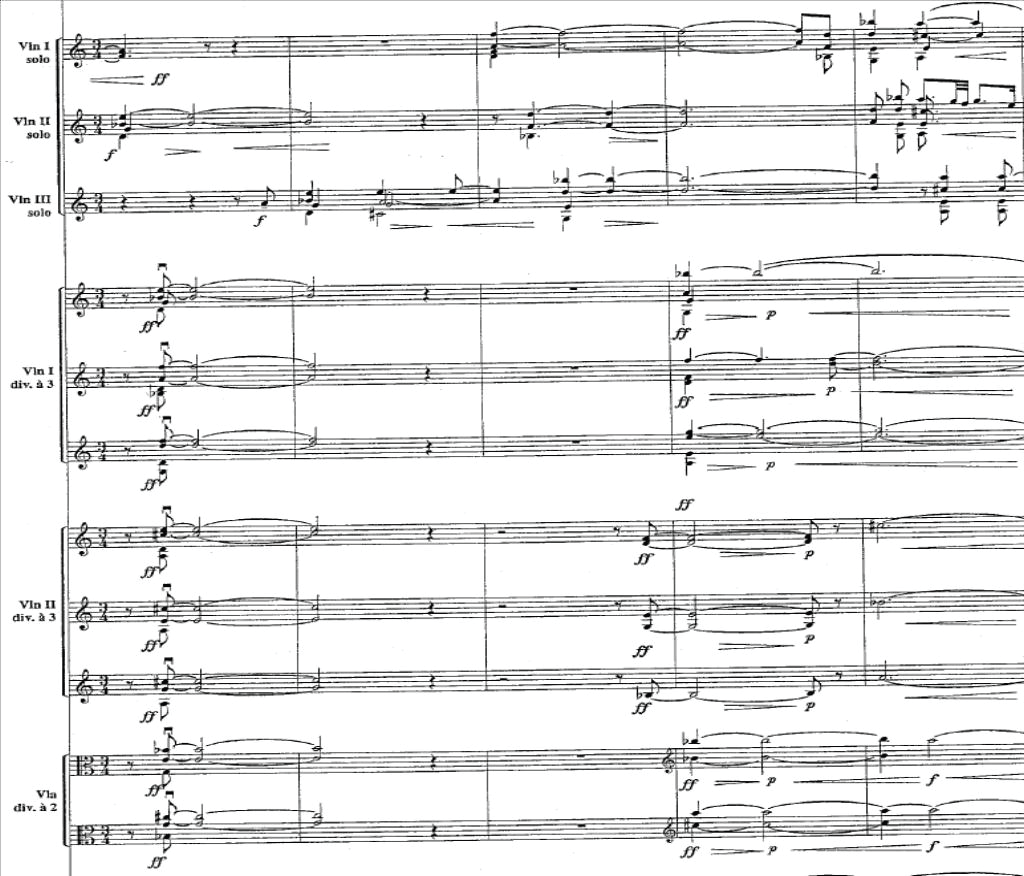
The character of the ornamental patterns, which initially appear as an interlude played by the instrumental ensemble and then together with the piyut and the theme of the Chaconne, changes from Bach’s fast-paced, sequential-variational progression to a melodic movement with an improvisational feel, which in the new version gives a slight sense of a Mediterranean style. Unlike the dramatic split of the Chaconne between the violins, which ended with a fff, here we have a soft movement (the dynamics are mostly ppp) with gentle dynamic changes.
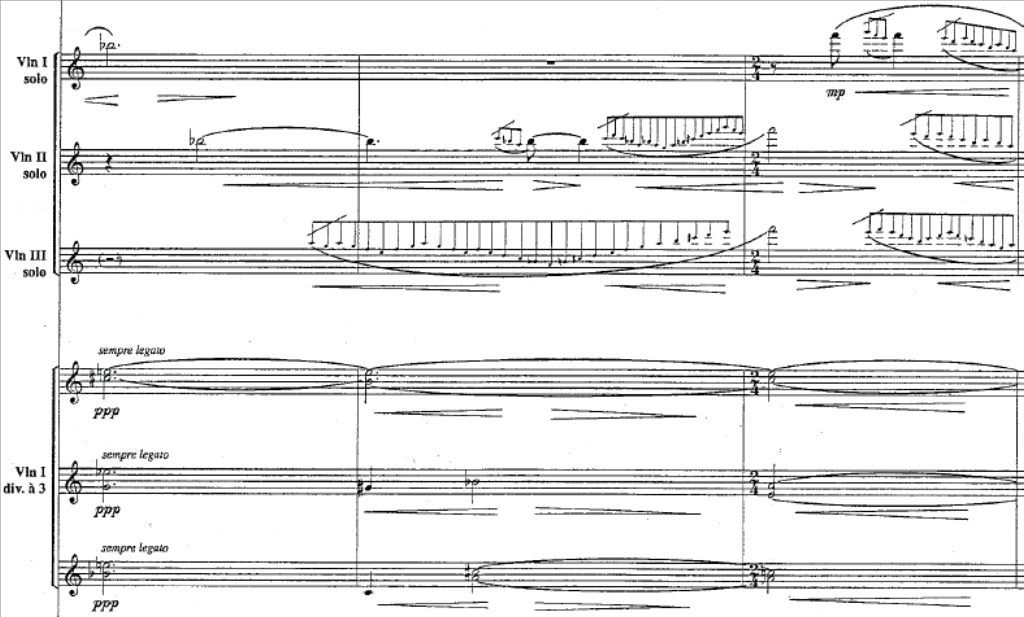
Despite the quotation of the original material, the many fermatas, and the free rhythm, the singing style contributes to bridging the gap between the piyut and the Chaconne and, to a large extent, disassociates the piyut from its folk context. The textural complexity that is created from the combination between it and components from the Chaconne, in all of its appearances, creates a deceptive feeling and gives them both a new musical and aesthetic meaning that is different from the meaning that was expressed in each of them separately. Toward the end of the work, the complexity of the blend between them intensifies, as the different ideas that appeared in the work, the melody of the piyut, the theme of the Chaconne, and the ornamental patterns all appear simultaneously. While the piyut sticks to the original musical setting, the accompaniment of the instrumental ensemble combines between tonal progressions in broken chords played by the strings and dissonant ornamental patterns. The patterns are characterized by rapid movement between dense intervals or intervallic leaps and shifts between registers on the solo violins and the clarinet. These quickly change into dramatic components that originate from the opening motive.
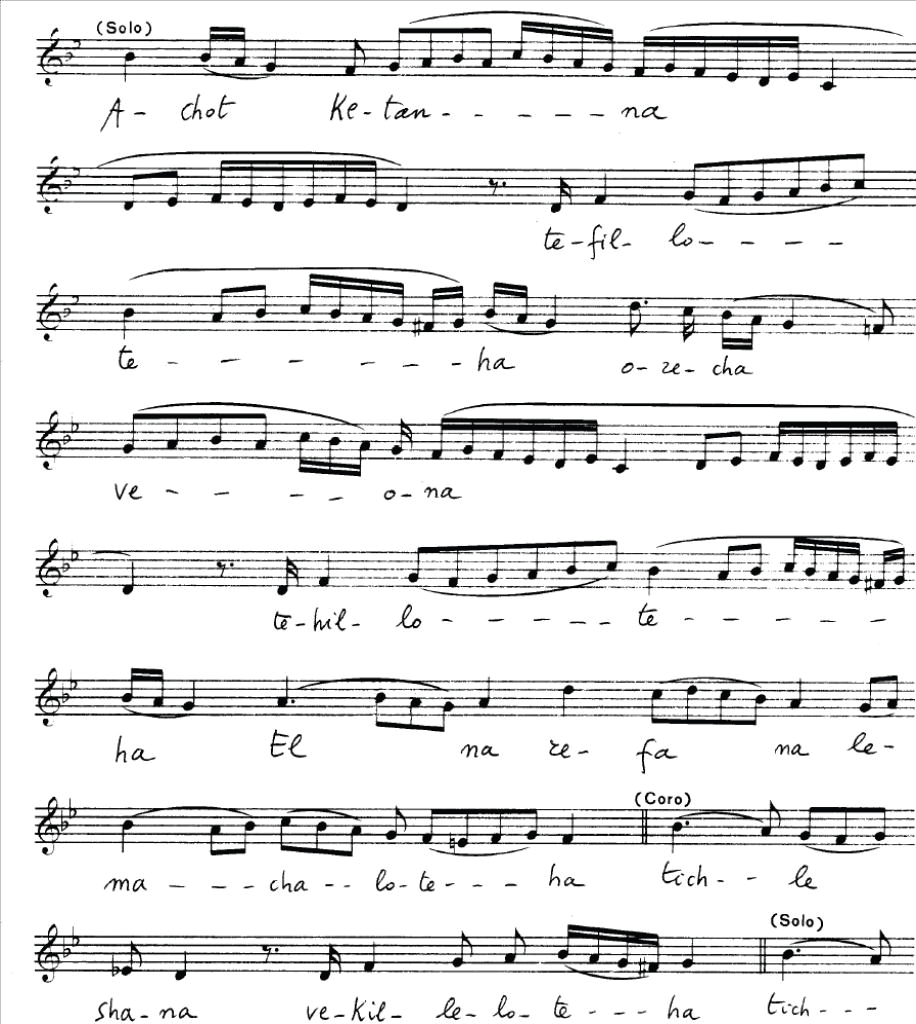
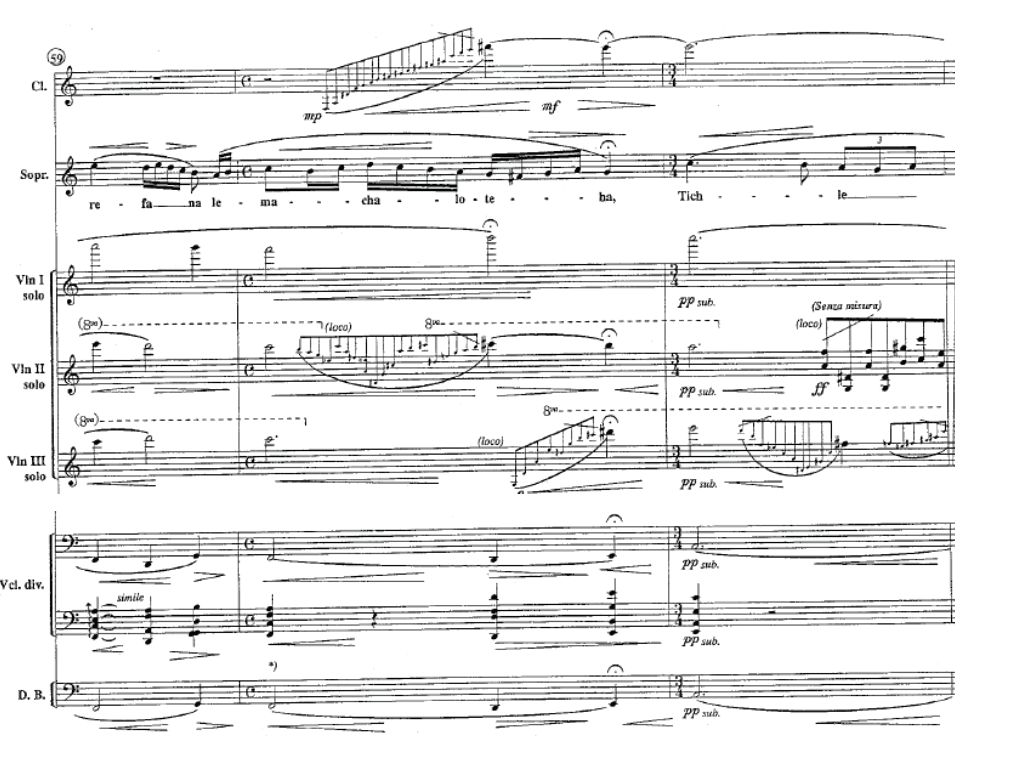
The main idea of the Chaconne as a set of variations on the main theme serves as a basis for free musical interpretation. At the opening of the piece there are intervals from the Chaconne, but with a variation so far from the original it is hardly recognizable, and later on the main theme serve as the basis of two variational appearances. Components from the ornamental patterns, which themselves constitute a variation on the original patterns, are incorporated together with other components. Thus the new interpretation of the material borrowed from Bach is crafted not only as a perpetual variation on the external material, but also on the different ways in which the borrowing is presented in the piece itself.
The main idea of the Chaconne as a set of variations on the main theme serves as a basis for free musical interpretation.
As mentioned, the two most stable elements in the work are the D minor chord that opens the Chaconne and the piyut that appears in full, almost constantly, throughout the entire piece. That being said, their stability is disturbed by the many combinations and changes that take place as they appear. Alongside the sense of instability, the repetition of the chord and the intervals that appeared in the opening together with the extreme dynamic fading (from fff to ppp) create a sense of summary and the closing of a circle at the end of the work. Additionally, despite how the complex moment is crafted, the variational relations between the different events, as well as the relation between the opening and the ending, lead to the creation of a sense of a master plan that unites between all the events in the work.
At the center of Achot Ketana there is a combination between two seemingly contrasting materials. Olivero uses them as equal raw materials that influence the different musical parameters. Alongside the emphasis on shared attributes that create stylistic cohesion, chief of which is the ornamentatality, the uniqueness of each one of them is preserved. The preservation of the tight connection with the original material emphasizes that this is recomposition of existing materials. That being said, through the pronounced change that they undergo, Olivero underlines her own personal perspective, which expresses contemporary aesthetic and musical tendencies.
# (2) Troubadours and Ladino songs in Zimaar I
The texts and musical settings that appear in Zimaar I are taken from love songs in Ladino from congregations in Greece, Turkey, and Morocco and from a song-poem by the French troubadour Folquet de Marseille.[21]
In her remarks on the piece, Olivero describes the character of the Ladino songs and the process that they undergo in her work:
“During the Middle Ages, Sepharadi Jews were influenced in their poetry and song by the epic knightly literature and the troubadour songs or cansos on the one hand, and by Arab-Moresque music on the other. Later, during their wanderings after the expulsion from Spain, the Jews characteristics of the populations they happened to live with […] The material I used in my compositions is assimilated, elaborated and often transformed by living, studying and listening to the voices of this century. I have also tried, as far as possible, to underline the subtle, mysterious links that have enabled so many different elements to metamorphose and blend together.[22]
The two opening songs are Kamini por Altas Torres (I have climbed the highest mountains) and Esta Montaña d'Enfrentre (This mountain in front of me), both sung in the Greek version. Following them is the troubadour song Sitot me soi a tart Aperceubutz (Although I realized it too late) and then the Turkish song Noches, Noches, Buenas Noches (Good Nights), which includes two lines that are borrowed from the Moroccan song Alta Luna Al Esclarecer (When the dawn breaks). The texture is characterized by the high density of the vocal materials, which, although they are taken from different sources, change intermittently from one to another without a substantial pause. The use of the original songs is dynamic and ranges from quotations with rhythmical variants, ornaments, and pitch changes to more substantial changes (although the original melodic gestures usually remain intact).
In the score, the composer writes that the aim of the free rhythm she uses in abundance is to blur the sense of a beat in the framework of the set bar length. Nevertheless, the performers can add measured rhythm if there is a need to coordinate, as long as the free character of the music is preserved. As in other works by Olivero, there is extensive use of fermatas as a meeting point between the instruments and the voice.
The simultaneous reference to different musical traditions crafted in a contemporary style is emphasized in the different instrumental parts, especially the harpsichord. Throughout the 20th century, many composers—including Penderecki, Carter, Ligeti, and others—have used the unique timbre of the harpsichord and its mechanical attributes to get unique effects in solo works and ensemble settings. Oftentimes, the use of the harpsichord refers to Baroque traditions such as utilizing different registers to create diversity of tone and ornamentality. The tone of the harpsichord in Zimaar and the use of its characteristic patterns (such as broken chords and abundant ornaments) gives the feeling of the instrumental accompaniment of a Baroque recitative.
Simultaneously, the gesture of plucking neighbouring notes creates a timbre similar to that of a qānūn, a string instrument that plays an important role in Arab instrumental ensembles. In order to still accentuate the contemporary context, Olivero adds abundant dissonances and melodic, harmonic, and rhythmical clashes between the harpsichord and the instrumental ensemble.
The way the opening chord is built above D alludes to a Baroque-recitative-style opening that prepares the entrance of the singer, while the melodic pattern is built from neighbouring notes that pile up on each other, creating a delayed sound cluster, which is joined by delayed/suspended sounds accompanied with violin appoggiaturas, featuring various aesthetic gestures that include Baroque ornamentation, Middle Eastern decorations, and dissonance. The dramatic effect of the opening is intensified through the extreme dynamic changes and multiple fermatas in the second bar. The entrance of the singer in the Ladino song is accompanied by a series of broken chords on the harpsichord, which throughout the first vocal section plays a progression of chords to which seconds are added, enriching the harmonic tone, which is based on pitches taken from the melodic line.
The way the opening chord is built above D alludes to a Baroque-recitative-style opening that prepares the entrance of the singer, while the melodic pattern is built from neighbouring notes that pile up on each other, creating a delayed sound cluster, which is joined by delayed/suspended sounds accompanied with violin appoggiaturas, featuring various aesthetic gestures that include Baroque ornamentation, Middle Eastern decorations, and dissonance.
In the absence of a defined meter, the harpsichord serves as an organizing harmonic and rhythmic component. Simultaneously, the stable structure of singing with instrumental accompaniment is disturbed by the appearance of variational patterns on the main tune, which are played by the violins and create a heterophonic structure in reference to the voice. The new version of the opening song is not identical to the original song, but it is built on two important melodic gestures taken from its beginning: the ascent by a second, accompanied by a descent and a rise to a higher interval (a fourth in the original, a fifth in the new version).
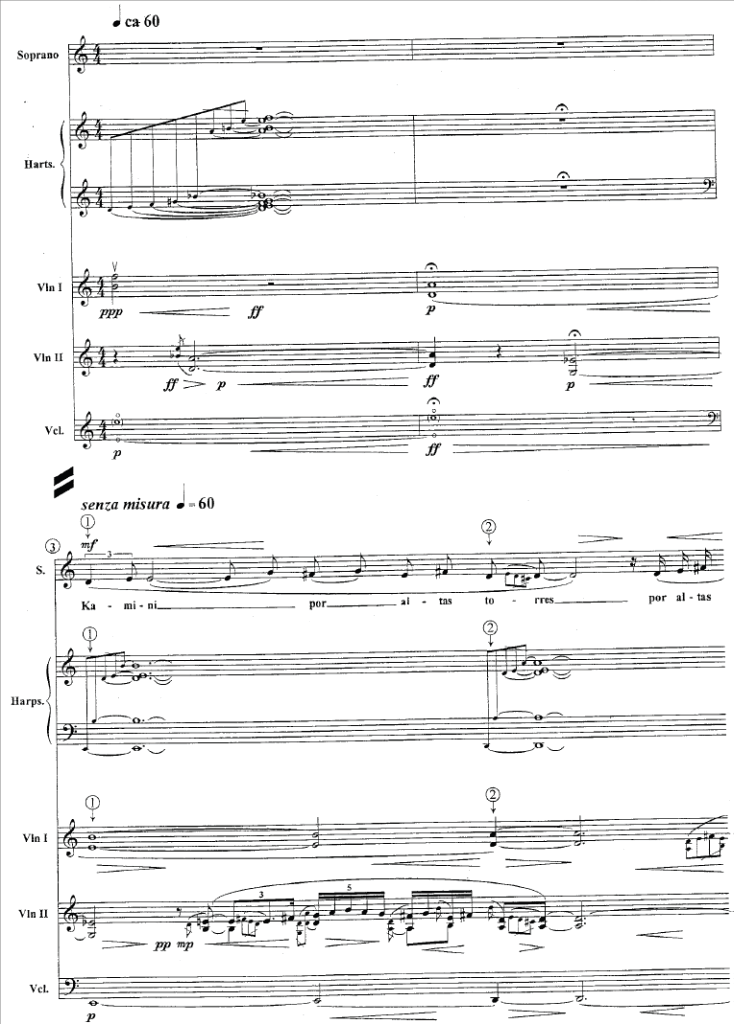
The instrumental section that appears after the opening functions as a kind of Ritornello whose meter, despite being measured, changes almost every bar. The rhythmic instability; the emphasis on fifths, fourths, and sixths; as well as the use of many leaps, are largely influenced by the style of Berio, especially in the fourth song of Folk Songs (Rossignolet au Bois), in which the melody of the song opens in fifths accompanied by fifths on the clarinet together with leaping up-and-down melodic motion on the harp and gentle percussion.
The fourths played simultaneously on the harpsichord, which clash with the calm character of the Ritornello, imply both a plucking style characteristic of a qānūn and a Western musical style typical of the 15th century. The singer joins the harpsichord and the instrumental ensemble for the song Esta Montaña d'Enfrentre, a very free interpretation of the original version. In contrast to the close-step movement that the original song features, the vocal line uses intervals larger than an octave, which blur the flow of the melody. Later in the piece, the harpsichord features both profuse ornamentation among adjacent notes on the one hand and contrary motion in large intervals (some of which are augmented and diminished) and large leaps on the other.
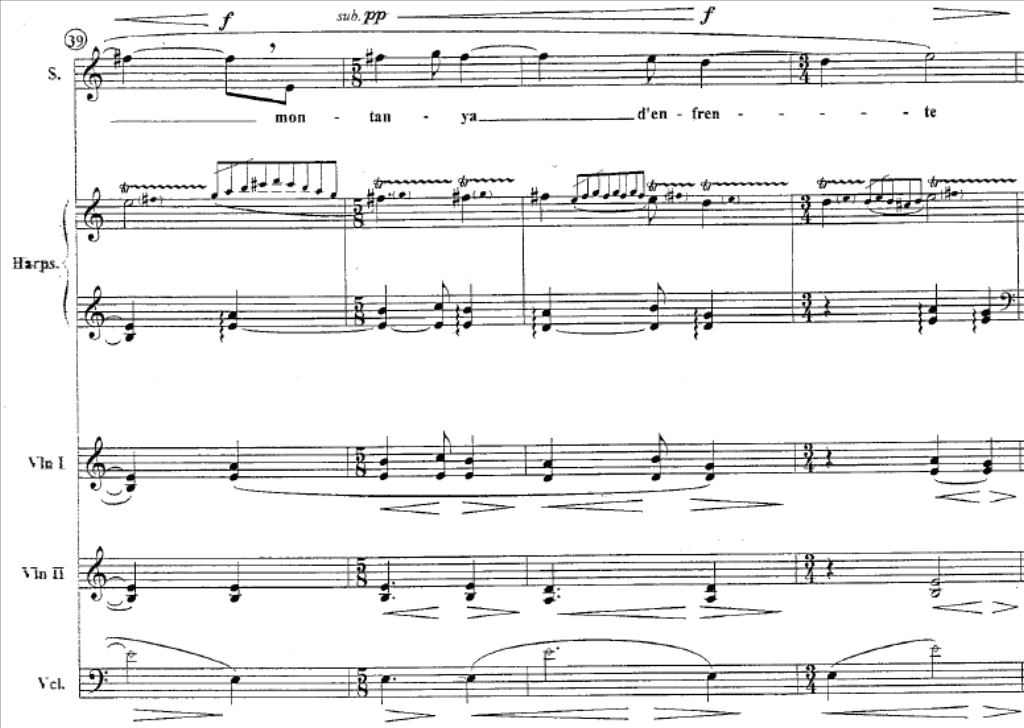
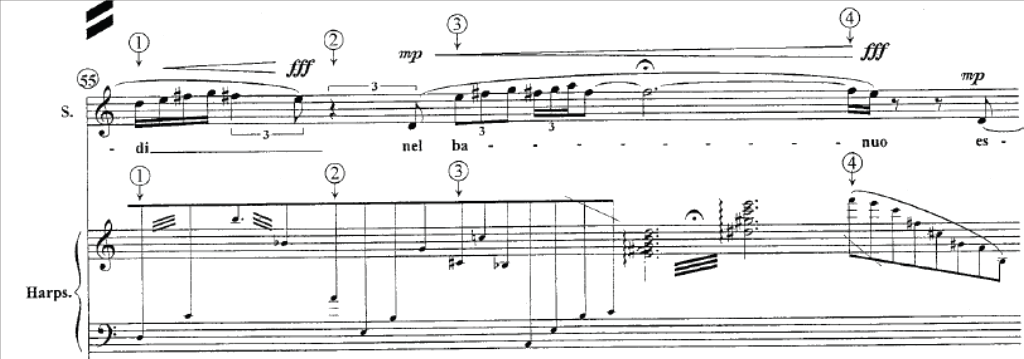
The heterophony between the strings and the voice serves as an important technique throughout the entire piece. Most of the time, the voice comes first and the violin follows a bit later; sometimes the violin comes first. In both cases there are meeting points between the two that take place on central notes of the melody, and the melodic line remains fairly unchanged. The simultaneous appearance of a melodic line similar to the original tune in the instrumental ensemble both strengthens the melody and creates a dialogue between the different roles, adding to the wealth of sound and to the complexity of the momentary musical events. Although this characteristic appears right from the beginning, toward the end of the piece the heterophony is accompanied with a higher density of simultaneous musical materials. As in Achot Ketana, this density leads to a high level of momentary complexity.
Although the original melodic gestures are preserved in the orchestration of the troubadour song, the gentle ornamentality of the melodic line, which accompanies the original rhythmic values, now turns into a dramatic ornamental melodic line with complicated rhythmic values. Additionally, the vocal part receives different interpretation in the violins and cellos, which are in dialogue with the melodic line. The three notes—B-flat, A, and G—which appear as a triplet in 16ths in the vocal part (originally F-E-D, fourth sentence, te-ner) are elongated and played in an inversion (ascending instead of descending) on the first violin, with additional rhythmic nuances on the second violin and cello. In the first violin, the ascending melodic pattern fits the ascending melodic direction in the continuation of the melody.
![Example 2.C: An excerpt from the song Sitot me soi a tart aperceubutz (taken from Rosenberg et al., 1998, p.147)] (https://media.graphassets.com/RARfQdzQaeHo2ml8EUpg)
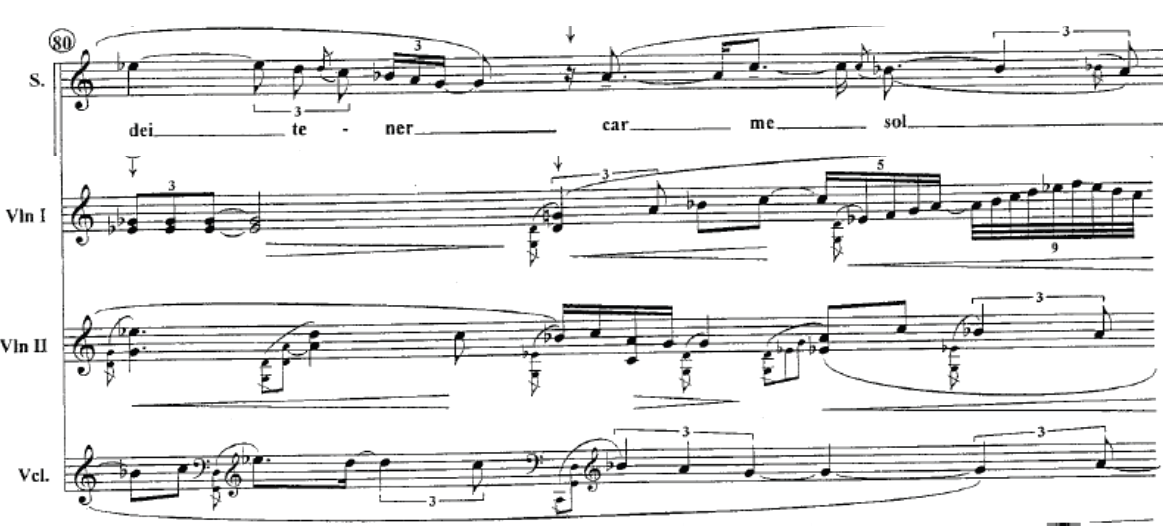
At the end of the work, there are two lines taken from the closing song: Los ojos me seseran/ De tanto ver la mar.[23] The instrumental texture becomes more compact in order to emphasize the vocal recitative in the song Noches, Noches, which is accompanied with the cello alone as the original tune is faithfully preserved with the addition of abundant ornamentation. This way Olivero returns to the original material—almost without additional compositional interference. As in the second song, the vocal line returns to extreme intervals, larger than an octave. The transposition by an octave replaces the dense melodic movement of the original song and adds, simultaneously with the repetition of specific pitches, to the static feeling of the melodic movement. This movement is accompanied with quiet delayed patterns which repeat themselves until the complete fading away of the music.
The unique tone of Zimaar I is the result of its many aesthetic allusions, which combine between a Baroque musical style, Mediterranean elements, and a contemporary musical style that includes dissonance and frequent use of sounds clusters. Unlike in Achot Ketana, there are more substantial changes in the melodic structure of the song’s musical settings, which means that the distance from the original material is larger. The work does not offer a solution to the contrast between the different styles, but rather presents them side by side. The blending between the different songs as a long recitative with instrumental interludes stresses the common idea shared between them as love songs and preserves the lyrical tone at the center of the piece.
# (3) Monteverdi and Arabic Music in the work Neharot, Neharot
Unlike other pieces, Neharot, Neharot was composed under the influence of a political event: The Second Lebanon War. The sights and sounds of war lead to the choice of a universal lament, dedicated to women and children in war zones. The title has a double meaning: it references two rivers, the river of blood and the river of tears, which flow through the events of wartime; and it references the concept of “Nehara,” which is taken from the same Hebrew root and which means “a ray of light.” Olivero explains: “It is like a river that flows through history and carries us with it, but returns to the ocean and unites with it in hope.”[24]
This work expresses well the seemingly conflicting Western and Mediterranean cultural influences on Olivero. While the Mediterranean borrowings are not from a Jewish source, the title of the work, the context in which it was written, and the tendency to use Middle Eastern material is deeply related to Israel. The Mediterranean voices and the materials borrowed from the works of Monteverdi, which appear simultaneously, influence each other. Like in Achot Ketana, the same combination adds to the deep complexity of the musical materials. That being said, Neharot, Neharot is longer and more complex.
The magnetic tape features the voices of mourning women from the Mediterranean Basin with two soloists (Leah Avraham and Ilana Elia). Among other things, there is also use of the famous Kurdish song “Fermane” (whose title means “destruction”), a symbol of the Kurdish struggle against the cruel Iraqi regime. Elia has stated that she had first learned the song from Turkish-Kurdish workers that came to work in Jerusalem and that she has since collected other versions of it.[25]
The composer chooses to borrow from Monteverdi, from the first part of the second madrigal of the Eighth Book of Madrigals, Madrigali Guerrieri et Amorosi (1638), which is based on a Petrarch text entitled Hor che'l ciel e la terra (“Now that the sky and the earth…”), as well as from four different excerpts from L’Orfeo (1607).[26] The same excerpts appear in a different order than they do in the original work, in such a way that Orpheus’ lament, which appears first in Monteverdi, appears as the final borrowing in the new work. The rest of the excerpts include the choir of nymphs and shepherds that follow the lament in the second act ("Ahi caso acerbo"—“Ah bitter blow”) and two sinfonias from act two and three. The work is built in five continuous sections that merge into each other, the last of which, featuring Orpheus’ lament, is referred to as an “epilogue.” It is interesting to point out that Olivero did not choose borrowings from one of Monteverdi’s explicit lamentos, Lamento d'Arianna, which has become the archetype of this musical genre, or the Lamento della Ninfa, which is known for its use of a descending minor tetrachord as the basis for the musical progressions, but other fragments that better fit the spirit of mourning and lament in her work.[27]
At the center of the madrigal’s text, whose musical setting opens the work, there is a contrast between pain and hope. The lover is in the midst of an emotional storm due to the conflict between his love causing him grief and its being his only comfort. The contrast between pairs of words such as guerra-pace (war and peace) and moro-nasco (birth and death) is especially suitable for the character of Olivero’s work.
Guerra è’l mio stato, d’ira et di duol piena/ e sol di lei pensando ho qualche pace […] mille volte il dì moro e mille nasco, tanto dalla salute mia son lunge.
"Warfare is my state, full of anger and pain, and only thoughts of her bring any peace […] a thousand times a day I die and a thousand times I am born, so great is the distance from my salvation".
Like Petrarch’s text, L’Orfeo is based on contrasts. These contrasts are expressed not only in the character of Orpheus, who is a demi-god, but also in the organization of the work’s movements and tonal structure.[28] Expressions of past and present, of sadness and happiness, and of a pastoral world that expresses the joy of life against the darkness of the afterlife are all represented with harmonic changes that include many shifts between sharps and flats, that is to say, between cantus durus/mollis according to the 17th-century tonal system.[29] Orpheus’ lament, which is borrowed at the end of the work, opens with a contrast between life and death, which is expressed in the pairing of the words morta and vita and in a breath that expresses the force of life:
Tu sé morta, sé morta, mia vita ed io respiro?
"You are dead, yet I still breath?"
Olivero chooses to use minor, exceptionally sombre excerpts from L’Orfeo, which include the shepherds’ choir not in its pastoral moments (like those of the first act) but in a minor section, in which the text emphasizes the cruel fate that destabilizes man’s trust in the merely ephemeral good. That being said, corresponding to the meaning of the title, it features, as the entire Monteverdi opera does, frequent shifts between a major and minor tone.
Both groups of strings have similar melodic materials, but they contrast each other harmonically. The original melodic lines are preserved, but they undergo a clear transformation, mostly due to the use of the second string ensemble to blur the harmonic stability that is intensified by the sound clusters played by the accordion. As with the ambiguity of the harpsichord in Zimaar, the accordion in this work serves two aesthetic and musical purposes: one is providing folk-like ornamentation, of the kind that is normally associated with this instrument, and the other is playing sound clusters, which are in line with its contemporary uses.[30] The percussion instruments add different colours—usually soft and non-dramatic ones, except for the dramatic entrance of materials from L’Orfeo—and at the center there is a solo viola, which engages in a dialogue with the different groups of instruments. The change in the performance medium (in this case, the vocal material which is transferred to instrumental performance), the blending between melodic lines from the opera and Mediterranean melodic lines, and the combination of live performance and pre-recorded material all add to the abundant complexity. The Mediterranean influence on the materials taken from Monteverdi is expressed in the improvisational character of the melodic lines and in the ornamentation, which has a Baroque feel but is crafted as a sequence of Middle-Eastern ornaments.
The madrigal serves as the main musical material of the opening section, and a paraphrase of it also appears in the third section. In the opening of the original madrigal, a threatening calmness is described and is expressed musically through a static movement of chords around A minor, while the harmonic movement in the bass moves between distinct harmonic steps. The ending in an A major chord serves as a dominant to the following chord, D major, in which an awakening begins with the words "veglio, penso, ardo" (“I awake, I think, I burn”). According to Jeffrey Kurzman, this part serves as the epitome of the variational repetitions and the texture that had grown thicker throughout the opening, while the change in the character and style symbolizes the shift between the calm nature description (arsis) and the awakening (thesis).[31]
The madrigal serves as the main musical material of the opening section, and a paraphrase of it also appears in the third section.
The new work preserves many characteristics of the original work, such as the A minor tonal region, static chord movement, and a basic harmonic pattern that descends from tonic to dominant through melodic movement in tight intervals. The last of these alludes, like the original, to the minor tetrachord that is characteristic of the lamento. In the second section, there is a notable change in the texture and in the character after the transition from a dominant built on A to D major, which is the harmonic center of the next section. As in the original madrigal, both these changes and the transition between sections create a similar sense of Arsis and Thesis. The first ensemble stays constant and faithful to the original, whereas in the second ensemble variety is added to the movement in the beginning of the piece through rhythmic displacement and the introduction of different intervals that create dissonance in relation to the main melodic lines. The mysterious character of the original is also preserved and brought out by the performance instructions (Misterioso), but the context is new.
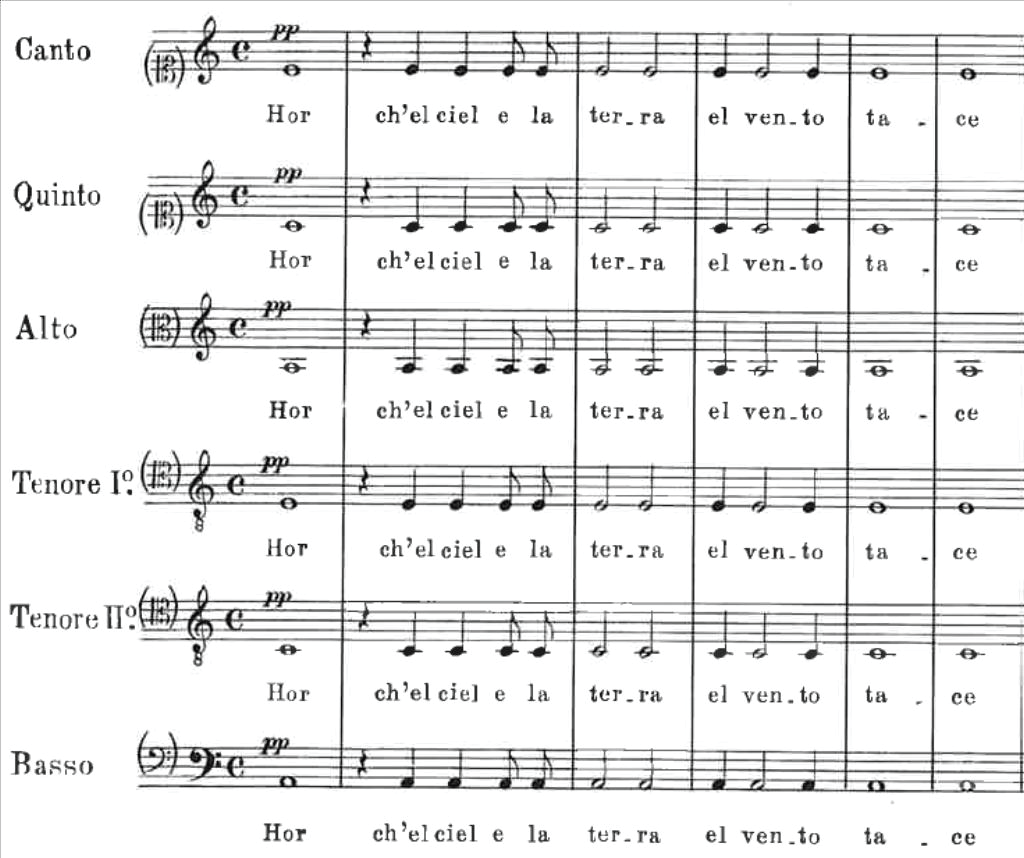
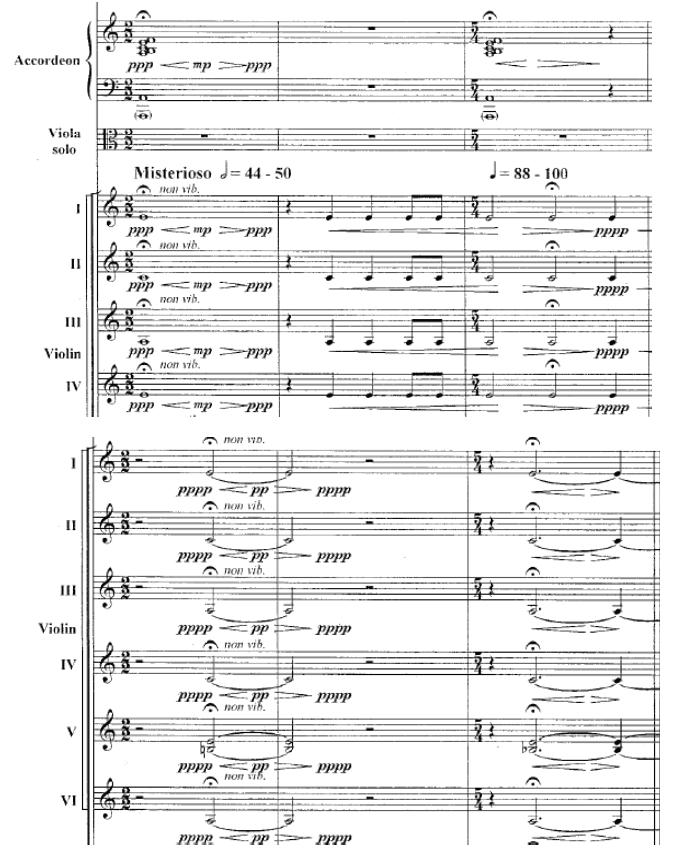
A similar technique of creating contrast between two string ensembles also characterizes the crafting of the three first borrowings from L’Orfeo in the fourth section. The sound complexity of the borrowings intensifies. For instance, in the second borrowing, not only are dissonant pitches and rhythmic diversity added to the main melody, but the solo viola simultaneously plays variants of the melodic lines. While the melodic movement on the viola is based on pitches that serve as a variant of the melodic line borrowed from Monteverdi, its character, which moves in seconds among adjacent notes with appoggiaturas and many ornamental notes, alludes to a Mediterranean tendency. In the third borrowing, too, the original progression is preserved in the first ensemble, but the entire second ensemble deviates from the quotes. The texture undergoes diminution to the point of the disappearance of the first ensemble, leaving only the dissonant intervals, which lead to the epilogue at the end of the section.
The next example focuses on an excerpt from the second borrowing, which is taken from a sinfonia that appears three times in the second and third acts, in D minor, and appears twice here, consecutively, in E minor. The tone is built from three layers of sound: melodic lines borrowed from Monteverdi, which are played by the first ensemble; dissonant interval combinations built on the notes of the melody in the second ensemble and the accordion; and ornamental patterns with an improvisational character, played by the viola on pitches that originate from the melodic line (but do not run parallel to it, appearing either slightly before or after it). The original melody, which is characterized by a melodic movement in adjacent notes, represents the Baroque ornamentation characteristic of L’Orfeo, together with the Maqam-like character of the crowded movement around central notes.
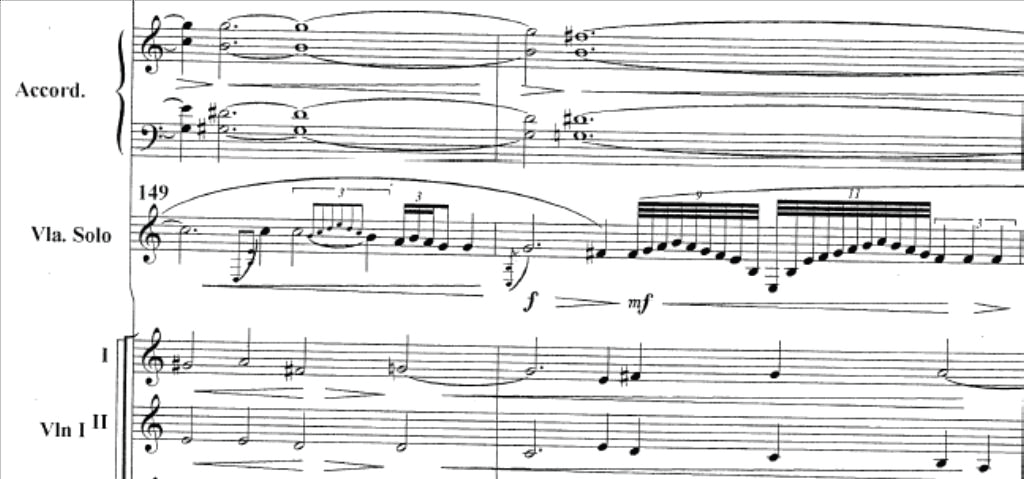
The combination between the live performance, which is subject to change and interpretation, and the recorded material, which appears in the third section and the closing section, creates a lot of tension. The second section is characterized by a prolonged heterophonic dialogue between the solo viola and the orchestral ensemble, in which the interchanges between the violas create a complex tone in which their parts merge in the acoustic space and the diverse percussion instruments—which include a gong, Tom-tom drums, bells and more—also add to the richness of the orchestral tone. Its calm character, which is created through the continuous movement built through constant, almost minimalist repetition of the same melodic lines with slight variations, changes with the dramatic nature of the third section.
The combination between the live performance, which is subject to change and interpretation, and the recorded material, which appears in the third section and the closing section, creates a lot of tension.
In this section, the song Fermane appears in recorded voices doubled by the viola. The constant melodic motion around the same pitches that return again and again (A, B-flat, and later also B natural and C) allude to a Maqam-like melodic tendency. The appearance of the song on top of variational material from the madrigal, and the notable contrast to the second section, intensify the level of momentary complexity of the musical materials.
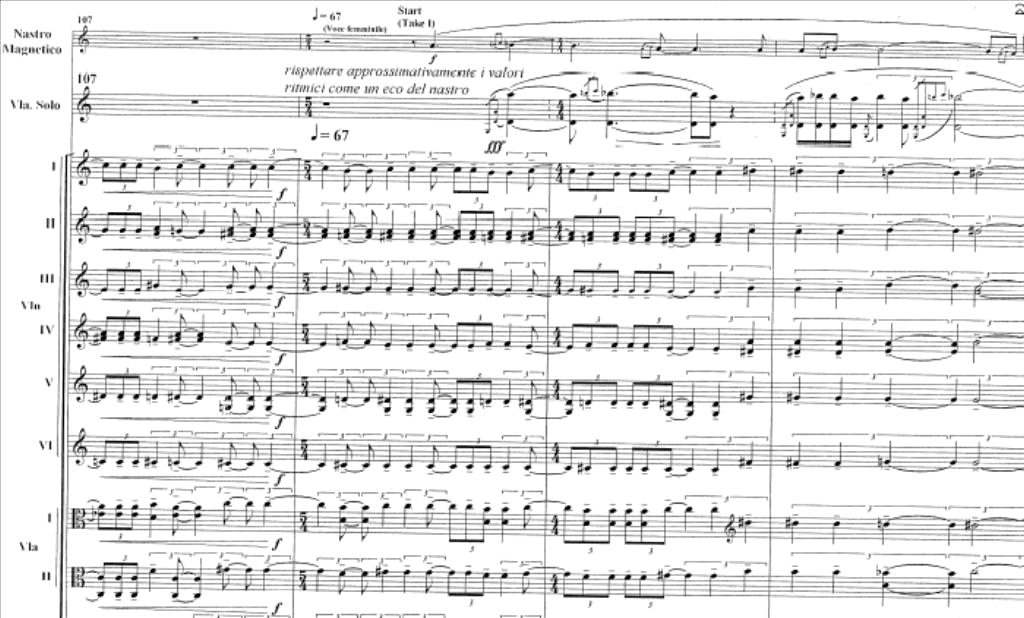
In the closing section the recorded sounds are played once again, this time with double-voiced heterophony. The “Epilogue” title emphasizes its role as a summarizing perspective on the work. As with the previous borrowings, the original melodic material is preserved and so is the tonal framework of the lament. That being said, the incorporation of the magnetic tape and the shift from the vocal medium to the instrumental medium create a new music, free from the limitations of the text, which now appeals not only to the personal grief of the protagonist, but to the universal grief of all of humanity, thus emphasizing the main message of the piece.
It is interesting to point out that the viola, which is played live, is the one appealing to the musical past, while the recorded voices, which remain identical in every performance, are of an improvisational nature, “authentic,” and immediate. Like the broken-chords accompaniment in the opening of Zimaar, the percussion accompaniment pattern alludes here to the Baroque, but the combination between the different components clarifies that this is a contemporary complexity. As in the other works discussed, the sense of fading away at the end of the piece is brought out by a gradual diminution of the texture into one voice: a solo viola and an accordion. In the end only the viola remains, accompanied by the quiet, continuous sound clusters on the accordion. The role of the viola in the ending of the work illustrates the constant transformation of the musical materials, which are taken not only from external borrowings, but also from original material from earlier works. In this case it is the main motive in the viola part, which is taken from the work Bashrav and is itself actually based on an earlier work by Olivero, Per Viola (1993) for solo viola.
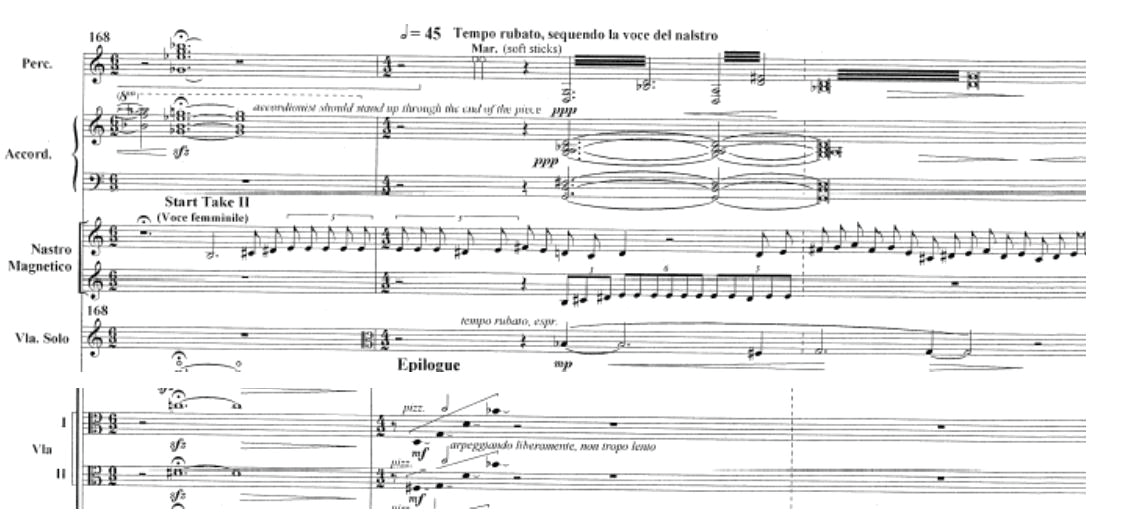
The work Neharot, Neharot directly expresses, without compromise, a social statement regarding the global nature of the pain of war, reaching a climax in the epilogue, when the lament and the recitative appear simultaneously. As in Achot Ketana, there is constant give-and-take between the borrowings. Although the recording of the folk singing without artistic processing serves as means toward its preservation, the extreme transformation that it undergoes due to being combined with the viola and the entire orchestral ensemble puts it in a new light. Similarly, Monteverdi’s music is also put in a new light that fits the contemporary situation through an array of orchestration devices.
# Recomposition and Personal Interpretation
In his article “Translating Music,” Berio explains that musical arrangement is part of the translation phenomenon at the center of the entire development of culture.[32] One of the aspects of arrangement is a new interpretation of components from the past and their assimilation into the new music. Olivero applies this concept, as the different borrowings are assimilated into the contemporary musical style on several levels of meaning: the borrowed material stands not just against its presentation in the original work, but is confronted with additional borrowed material in order to create a contrast or a merger between them. In the three works discussed, clear connections, as well as substantial changes, have been found between the borrowed materials and their original sources. The new music is not Baroque, Arab, or Jewish. The musical style is not nationalistic; rather, the folk and artistic materials are used in order to express contemporary aesthetic concepts.
The perpetual change of the existing materials expresses, to large extent, the idea of an “open work,” which was described in detail by Umberto Eco.[33] In “Open works,” the composers choose to grant extensive autonomy to the performer on the rhythmic level, in determining the progression of events, and more. Olivero’s music usually does not enable free choices to the performers except for on the rhythmic level, on which there is some autonomy in the choice of note lengths, which are still predetermined, but in the framework of free rhythm. That being said, the open attitude in her works leads to an extensive absorption of external materials, together with the frequent recurrence of internal ideas, which are transferred between works and lead to constant changes in existing materials while constantly citing them in such a way that the musical past, both personal and cultural, is always incorporated in the present.
From an analysis of the works, it appears that the recomposition—through an array of techniques that enable the assimilation of the borrowed materials into the contemporary style—stands at the center of Olivero’s style. For her, the borrowed materials, both folk and artistic, serve this purpose. The merger between Jewish, Arab, and Western music exemplifies the dialogue that she aims to express in her works. Her work generates a lot of interest on the musical, aesthetic and cultural levels and presents challenges to the performer, the listener, and the scholar alike.
# Notes
[1] Despite this, it is worth noting that quotes/allusions from Israeli and Arab folk songs, as well as a quote from the beginning of Berio’s 1964 work Folk Songs, were incorporated into the early work Presenze (1985). As in other works by Olivero, there was an additional transformation when parts of it were expanded into a large-scale symphonic work (Merkavot, 1999), which itself includes expanded sections from two other works (Tenuot, 1990, and Kavei Avir 1995).
[[2] See for example Ronit Seter, "Olivero Betty,” Grove Music Online. Oxford Music Online; Jehoash Hirshberg, "Olivero Betty,” MGG Personenteil 12 (1994): 1357- 1358.
[3] For the longest and most detailed interview with Olivero see Robert Jay Fleisher, Twenty Israeli Composers: Voices of a Culture, Detroit: Wayne State University Press, 1997, pp. 271-279; additionally, on Olivero’s website there are short descriptions and audio files of most of her works: olivero.co.il
[4] Definitions for the different types of nationality and a description of Olivero’s national characteristic have appeared: Jehoash Hirschberg, “The vision of the East against the Legacy of the West: Ideological movements in music of the settlement period and their influence on the Israeli music of the last two decades” in Discussions of the Rebuilding of Israel 41 (2004) (Hebrew), pp. 11-31 as well in Ronit Seter’s “Is There a Doubt That There Exists an Israeli Style? Or There is no Israeli music —surveys on Israeli art music: 1953, 2003, 2008” in Tav +, 2008 (Hebrew), 26-27 and in her recent "Nationalism, Orientalism, Israelism and the Israeli Five,” Musical Quarterly 97/2 (2014), pp. 238-308; Nadav Ziv’s study on the epic-scale work Bakashot is the only article that delves deep into the work of Olivero. See Nadav Ziv, The Use of Ethnic Elements in Betty Olivero’s Work: Bakashot. Ph.D. diss. (Hebrew), Bar-Ilan University, 2001.
[5] Noam Ben Ze’ev, “Betty Olivero Connects Between All Worlds,” Haaretz Daily, September 26, 2013
[6] Ladino songs have received— in many cases, such as the arrangements of Paul Ben Haim and Yehezkel Braun—been relatively little attention in Israeli music and have used as oriental material that was stylized in a romantic, 19th-century manner. Noam Sheriff’s work Sephardic Passion, which is constructed around the model of the Baroque Passion in a style influenced by late romanticism, was composed in 1992 to mark 500 years to the expulsion of the Jews of Spain. In recent generations there have been occasional arrangements [of Ladino songs] in art music and popular music, such as Eitan Steinberg’s arrangements, but Olivero’s use of them is still an anomaly in its breadth and character.
[7] See Jessica Duchen, "Mid'East Rivers of Blood,” The Jewish Chronicle Online (2010). The interview took place ahead of a performance of the work Neharot, Neharot in England.
[8] For a detailed description of the different kinds of nationalities, see Hirshberg (2004).
[9] For a discussion on different attitudes toward nationality in music see Richard Taruskin’s entry “Nationanalism” for the Grove Encyclopedia of Music and Carl Dahlhaus, Between Romanticism and Modernism, (trans.) Mary Whitall, California: University of California Press, 1980, pp. 79-101.
[10] In an interview with Frank Oteri entitled "What it means to be an American composer," Leon described her views on different aspect of her work and music on music in general. See www.newmusicbox.org Other examples of combining folklore elements with modern composition can be found in the music of Somei Satoh in Japan, Roberto Siera in Puerto Rico, and others.
[11] Luciano Berio: Two Interviews: With Rossana Dalmonte and Balint Andras Varga, David Osmond-Smith, ed. and trans., (New York: Marion Boyars, 1985), p.107.
[12] “Betty Olivero” in The I.M.I. News, a quarterly published by the Israeli Music Institute (Hebrew) (1990:3), p.27.
[13] For an extensive discussion on the works of Ives and his use of musical borrowings, see J. Peter Burkholder, All Made of Tunes, Charles Ives and the Uses of Musical Borrowing, New Haven: Yale University Press, 1995.
[14] Rands’ comments are presented in the liner notes of a CD with a performance of the work, issued by Albany Records in 1999.
[15] See Jane Piper Clendinning, "Postmodern Architecture/Postmodern Music,” Postmodern Music, Postmodern Thought, (ed.) Judy Lochhead and Joseph Auner, New York: Routledge, 2002, pp. 119-140
[16] This is based on a conversation I had with the composer in 2013.
[17] J. Peter Burkholder, "The Uses of Existing Music: Musical Borrowing as a Field," Notes 50/3 (1994): 851-870.
[18] Olivero, who often uses diverse versions and arrangements, had already used this piyut in two earlier works that were composed in the 90s in different versions: she used the Sephardic version as the the tenth song in Juego de Siempre and she used the part of the text that opens with “El Refa Na” (God heal) together with another Ladino song in her piece Bakashot.
[19] The piece was commission by The Yehudi Menuhin Memorial Foundation. Menuhin himself described Bach’s Chaconne as "the greatest structure for solo violin that exists." See Yehudi Menuhin, Unfinished Journey, London: Macdonald and Jane's, 1976, p. 326.
[20] Noam Ben Ze’ev, “Betty Olivero Connects Between All Worlds”
[21] 19 songs (13 of them with a musical setting) have survived from the works of French troubadour Folquet de Marseille (1160-1231). Between 1180-1195, he composed his emotional songs, which are characterized by complex syntax together with a wealth of sound and rhythm. In his later period, he completely abandoned his artistic tendencies and became a devout and vicious Christian. See Rosenberg, Smitten, Le Vot (ed.), Songs of the Troubadours and Trouvers, New York: Garland, 1998, pp. 143-150.
[22] The quote above is taken from the composer’s website. It is interesting to see its similarity to words of Ladino scholars Armistead and Silverman, which emphasize the dynamic and constantly changing nature of the Ladino songs: "Over the past decades, much of our own work has shown that the Judeo-Spanish romancero, far from being only a treasure trove of medieval relics, is, in contrast, actually a dynamic, eclectic tradition drawn from a great variety of sources, both medieval and modern, Jewish, Christian, and Islamic, Hispanic, but also Balkan and Near Eastern, and indeed French and Italian as well […] we have stressed, in particular, the necessity of studying those elements which their repertoire has absorbed from Eastern Mediterranean folkloric traditions […] it is essential then, to view the Sephardic ballad tradition – like any other – as a vital, dynamic, creative phenomenon, forever involved in the ongoing process of becoming something different from what it was before".
See G. Armistead, Joseph H. Silverman, Juedo-Spanish Ballads from the Oral Tradition, Vol 1. "Epic Ballads,” Berkeley: University of California Press, 1986, pp. 3-4
[23] "Both my eyes have already gone extremely tired/from looking at the sea".
[24] From an interview with Duchen 2010
[25] For a full article on Ilana Elia, see Ben Shalev, “Lullabies and Lamentations,” Haaretz Daily, April 13, 2008. Already in the late 90s, the song Fermane sparked the interest of Mark Kopytman, who featured it in his work Fermane (1998) for a folk singer and three clarinets.
[26] This madrigal is divided into two, but Olivero just uses the beginning of the first part. The Eighth Book of Madrigals is also known for its forward, in which Monteverdi explains that his goal is to represent the agitated style (Concitato), the least developed among the three musical styles—the other two being the soft style (Molle) and the moderate style (Temperato)—that symbolized the three main human emotions—anger, moderation, and humility— as defined by the philosophers. Monteverdi explains that the sixteenth notes that appear in succession enable the expression of the agitated style. They are expressed in a later part of the madrigal, which is not quoted by Olivero.
[27] The Lamento D’Arianna, written to a text by Rinuccini, is one of the earliest operatic laments (first Eighth Book of Madrigals and set to published in 1608 as part of the opera Arianna). It also appeared in the Sixth Book of Madrigals (1614) as a monody and as a basis for a religious text (1623, 1640). This work, unlike an aria with a set structure, emphasizes in a more flexible way the entirety of Arianna’s tumultuous feelings based on the needs of the text. The Lamento della Ninfa, taken from the a different text by the same author, uses the descending tetrachord in the bass to create contrast and dissonance between it and the voice.
[28] For a more on the tonal structure of L’Orfeo see Eric T. Chafe, Monteverdi's Tonal Language, New York: Schirmer Books, 1992, pp. 126-157.
[29] This refers to the distinction between two types of hexachord, the “hard” and “soft” hexachords, both of which are built on a progression of six ascending notes. The “hard” hexachord ascends from G to E with a natural B, while the “soft” Hexachord moves from F to D with a B-flat.
[30] The use of accordion in contemporary art music is not common, although Gubaidulina often uses it in works such as De Profundis (1978) and Et Expecto (1985).
[31] See Jeffrey Kurzman, "A Taxonomic and Affective Analysis of Monteverdi's 'Hor Che'l Ciel e la Terra',” Music Analysis 12/2 (1993): 169-195.
[32] Luciano Berio, "Translating Music," Remembering the Future, Cambridge: Harvard University Press, 2006, pp. 31-60.
[33] Umberto Eco, The Open Work, (trans.) Anna Cancogni, Cambridge: Harvard University Press, 1989.